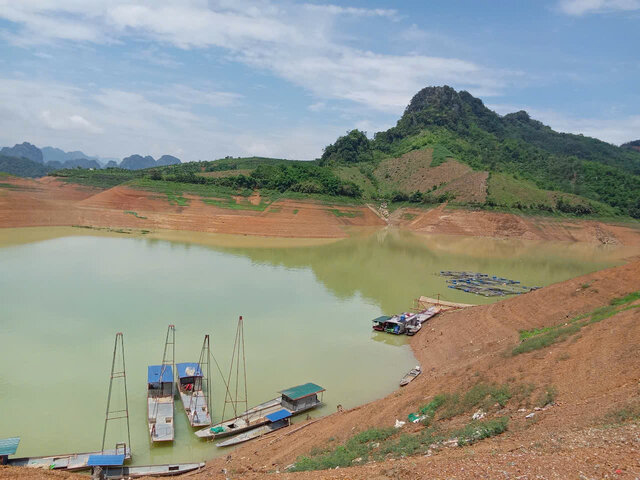In Lau Bai hamlet, Vai Nua commune (Da Bac district), where there are more than 60 fish cages operating, people cannot hide their worries. The water recedes, the water is cloudy, causing unpredictable changes in the fish farming environment.
Mr. Ly Quang Hoang - one of the households that have newly invested in 5 fish cages since the beginning of the year - said: "The water level is much lower than every year. If they continue to lower, the cage fish may die en masse. We hope that the authorities will intervene to support and provide technical guidance to reduce risks".
Not only in Da Bac, a similar situation also occurs in Thung Nai commune, Cao Phong district. Mr. Bui Quang Khanh, a resident of Nai hamlet, shared: The lake is now 200 - 300m narrower than before. Many households do not dare to keep fish for long, forced to sell them early to avoid damage".

According to Mr. Xa Van Si - Chairman of the People's Committee of vay Nua commune, the whole commune currently has more than 400 fish cages, distributed in 6/8 hamlets, which are the main livelihoods of hundreds of households. Previously, when the water level was stable, cage fish farming brought very good economic efficiency. But this year, the water level has dropped sharply, causing fish to die everywhere, making people very confused, said Mr. Si.
The commune government has advised people to move fish cages to deeper water areas, or where streams flow in to improve the water environment. However, some households that pumped stream water into fish cages themselves encountered a situation of "harmful profits" because the stream water was cloudy, easily causing environmental shock.
"If fish breeding support programs are still implemented at this time, the risk of damage will be even higher," Mr. Si expressed concern.
Talking to reporters, Mr. Hoang Van Son - Head of the Department of Animal Husbandry, Veterinary Medicine and Fisheries of Hoa Binh province - said: Currently, the entire Hoa Binh Hydropower Reservoir has about 5,200 fish cages. Although the water level has decreased, it is still within the allowable threshold for aquaculture.
The situation of fish deaths in recent times is not due to epidemics but due to low levels of soluble oxygen in water, caused by hot weather combined with early season rain, causing organic matter to flow from the hillsides to the lake.

Mr. Son recommends that people should proactively prune fish when they are of good size, and should not fish or release the fish on extremely hot days. At the same time, you should move the cages to water areas 2.5 - 3 m deep, placing them 1.5 - 2 m from the bottom to limit local oxygen shortages.
"People need to closely monitor the health of the fish, collect leftover feed, and cover the cages with a light-red net. On hot days, reduce the amount of food by 50 - 70% or temporarily stop feeding the fish. Prioritize the use of nutritious foods, combined with vitamin C, minerals and biological products to increase resistance, Mr. Son emphasized.
According to an update from Vietnam Electricity Group, on September 21: The current water level of Hoa Binh Lake is only 88.81m, 28,19m lower than the normal rising water level (117m), but 8.81m higher than the dead water level. This water level can still generate electricity, but the ability to store water is very limited.











